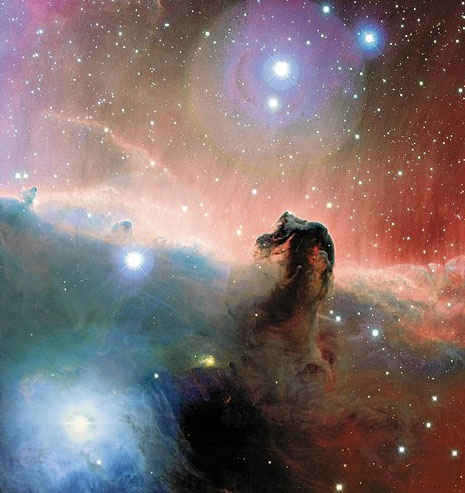Astrochemistry

The Horsehead Nebula, a dark molecular cloud known as Barnard 33 seen silhouetted against the bright emission nebula IC 434.
Image: J.-C. Cuillandre, Canada-France-Hawaii Telescope
Astrochemistry is the study of molecules in space -- the atomic and molecular processes which occur in and around celestial bodies. Much of what we have learnt about the universe has come from astronomical observations of molecules, starting with the detections of CH+, CH and CN in the 1930's. Presently, over 200 molecules have been detected in various regions of our galaxy, as well as over 40 in external galaxies. Astrochemistry is concerned with how these molecules are formed and destroyed, and also what these molecules tell us about conditions -- (column) densities, temperatures, radiation fields, magnetic fields, and so on.
Molecules also provide a way of probing processes which are otherwise hidden from view. For example, the early stages of star formation occur inside dense molecular clouds. As well as molecular gas, these clouds contain grains of dust which obscure visible light, so we can't 'see' what's happening inside them. Light at other wavelengths, such as radio emission from molecules, can escape the cloud, however, and we exploit this to learn about the star formation process.
Astrochemistry is a union of astronomical observation, laboratory experiment, chemical theory and computation, and each of these elements informs the others. It therefore encompasses a wide range of skills, which is one reason why we enjoy it.
Building on a long tradition of astrochemical research at UMIST,
research at the Jodrell Bank Centre for Astrophysics is focused on the
gas-phase and surface reactions around young stars, evolved stars and
in molecular clouds. Using the renowned

UMIST Database
News: The new (2010) version of the UMIST Database is in the final stages of development. It will be available to the community in the autumn. As usual, there has been a complete re-evaluation of all the rate coefficient data in the database, plus for this release there are several significant upgrades. These include the inclusion of a complete anion chemistry, the availability of 'reference' chemical networks for dark clouds and AGB circumstellar envelopes, and the release of the codes themselves.
Furthermore, the best bits of the on hiatus astrochemistry.net will be incorporated into the online version of this release, making udfa.net a comprehensive resource for astrochemistry.
Meanwhile, there's still UDFA 2006.
Line surveys
We also have a ongoing interest in spectral line surveys of molecule-rich regions such as Sagittarius B2, the Orion Nebula, the carbon star IRC+10216 and others. We have a large involvement in the James Clark Maxwell Telescope Spectral Legacy survey (SLS).
spectrafactory & splatalogue
As a further service to the molecular astrophysics community, we host, develop and maintain spectrafactory, an interactive database of synthetic molecular spectra. We were also instrumental in the design and compilation of splatalogue (spectral line catalogue), a database of astronomical spectroscopy data. This catalogue is the standard source of spectral line data for the ALMA project and is integrated into the Observing Tool and CASA data reduction environment.

Ph.D. research projects
We offer some student projects in astrochemistry and related subjects.


